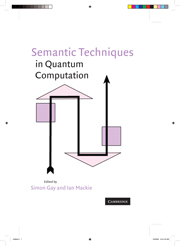Book contents
- Frontmatter
- Contents
- Contributors
- Preface
- 1 No-Cloning in Categorical Quantum Mechanics
- 2 Classical and Quantum Structuralism
- 3 Generalized Proof-Nets for Compact Categories with Biproducts
- 4 Quantum Lambda Calculus
- 5 The Quantum IO Monad
- 6 Abstract Interpretation Techniques for Quantum Computation
- 7 Extended Measurement Calculus
- 8 Predicate Transformer Semantics of Quantum Programs
- 9 The Structure of Partial Isometries
- 10 Temporal Logics for Reasoning about Quantum Systems
- 11 Specification and Verification of Quantum Protocols
- Index
- References
7 - Extended Measurement Calculus
Published online by Cambridge University Press: 05 July 2014
- Frontmatter
- Contents
- Contributors
- Preface
- 1 No-Cloning in Categorical Quantum Mechanics
- 2 Classical and Quantum Structuralism
- 3 Generalized Proof-Nets for Compact Categories with Biproducts
- 4 Quantum Lambda Calculus
- 5 The Quantum IO Monad
- 6 Abstract Interpretation Techniques for Quantum Computation
- 7 Extended Measurement Calculus
- 8 Predicate Transformer Semantics of Quantum Programs
- 9 The Structure of Partial Isometries
- 10 Temporal Logics for Reasoning about Quantum Systems
- 11 Specification and Verification of Quantum Protocols
- Index
- References
Summary
Abstract
Measurement-based quantum computation (MBQC) has emerged as a new approach to quantum computation where the notion of measurement is the main driving force of computation. This is in contrast with the more traditional circuit model that takes unitary operations as fundamental. Among measurement-based quantum computation methods the recently introduced one-way quantum computer stands out as basic and fundamental. The key idea is to start from an entangled state and then use measurements and one-qubit unitaries, which may be dependent on the outcomes of measurements, to guide the computation. The main point is that one never has to perform unitaries on more than one qubit at a time after the initial preparation of an entangled state. The “programs” that one writes in this model are traditionally called “patterns.”
In this chapter, we develop a rigorous mathematical model underlying measurement-based quantum computation. We give syntax, operational semantics, denotational semantics, and an algebra of programs derived from the denotational semantics. We also present a rewrite theory and prove a general standardization theorem that allows all programs to be put in a semantically equivalent standard form. Standardization has far-reaching consequences: a new physical architecture based on performing all the entanglement in the beginning, parallelization by exposing the dependency structure of measurements, and expressiveness theorems.
We use our general measurement calculus not just to formalize the one-way model but also several other measurement-based models, e.g., Teleportation, Phase, and Pauli models, and present compositional embeddings of them into and from the one-way model.
- Type
- Chapter
- Information
- Semantic Techniques in Quantum Computation , pp. 235 - 310Publisher: Cambridge University PressPrint publication year: 2009
References
- 17
- Cited by



